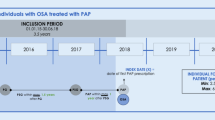Abstract
Purpose
Despite advances in continuous positive airway pressure (CPAP) technology, compliance with CPAP therapy remains suboptimal. Studies conducted since the advent of objective CPAP recording have noted that African Americans (AA) may use CPAP less than Whites. We sought to confirm this finding among a large sample of veterans and examine effect modifiers of the differential usage.
Methods
A retrospective cohort of 233 AA and 1939 White Veterans Administration (VA) patients who had a sleep study between January 2003 and October 2006 and received CPAP therapy by the end of 2007. CPAP compliance was summarized at 2 weeks and 6 months post CPAP receipt.
Results
AAs were significantly less adherent than Whites even when controlling for age, gender, marital status, median household income for zip code, BMI, comorbidities, and obstructive sleep apnea (OSA) severity. AAs with severe OSA were 3 times more likely to use CPAP than AAs with mild/moderate OSA (p ≤ 0.001); a much smaller but still statistically significant difference was seen for Whites.
Conclusions
CPAP compliance is considerably lower in AAs than in Whites, though severity of OSA modifies this association. These findings are not readily explained by differences in demographics or comorbidity.


Similar content being viewed by others
References
Avlonitou E, Kapsimalis F, Varouchakis G, Vardavas CI, Behrakis P (2012) Adherence to CPAP therapy improves quality of life and reduces symptoms among obstructive sleep apnea syndrome patients. Sleep Breath 16(2):563–569
Schwartz DJ, Karatinos G (2007) For individuals with obstructive sleep apnea, institution of CPAP therapy is associated with an amelioration of symptoms of depression which is sustained long term. J Clin Sleep Med 3(6):631–632
Campos-Rodriguez F, Pena-Grin N, Reyes-Nunez N, De la Cruz-Moron I, Perez-Ronchel J, De la Vega-Gallardo F, Fernandez-Palacin A (2005) Mortality in obstructive sleep apnea-hypopnea patients treated with positive airway pressure. Chest 128(2):624–629
Weaver TE, Sawyer AM (2010) Adherence to continuous positive airway pressure treatment for obstructive sleep apnoea: implications for future interventions. Indian J Med Res 131:245–258
Wickwire EM, Lettieri CJ, Cairns AA, Collop NA (2013) Maximizing positive airway pressure adherence in adults: a common-sense approach. Chest J 144(2):680–693
Scharf SM, Seiden L, DeMore J, Carter-Pokras O (2004) Racial differences in clinical presentation of patients with sleep-disordered breathing. Sleep Breath 8(4):173–183
Budhiraja R, Parthasarathy S, Drake CL et al (2007) Early CPAP use identifies subsequent adherence to CPAP therapy. Sleep 30(3):320–324
Joo MJ, Herdegen JJ (2007) Sleep apnea in an urban public hospital: assessment of severity and treatment adherence. J Clin Sleep Med 3(3):285–288
Pamidi S, Knutson KL, Ghods F, Mokhlesi B (2012) The impact of sleep consultation prior to a diagnostic polysomnogram on continuous positive airway pressure adherence. Chest 141(1):51–57
Ye L, Pack AI, Maislin G, Dinges D, Hurley S, McCloskey S, Weaver TE (2012) Predictors of continuous positive airway pressure use during the first week of treatment. J Sleep Res 21(4):419–426
Wallace DM, Shafazand S, Aloia MS, Wohlgemuth WK (2013) The association of age, insomnia, and self-efficacy with continuous positive airway pressure adherence in AA, white, and Hispanic U.S. Veterans. J Clin Sleep Med 9(9):885–895
Means MK, Ulmer CS, Edinger JD (2010) Ethnic differences in continuous positive airway pressure (CPAP) adherence in veterans with and without psychiatric disorders. Behav Sleep Med 8(4):260–273
Shaw R, McKenzie S, Taylor T et al (2012) Beliefs and attitudes toward obstructive sleep apnea evaluation and treatment among Blacks. J Natl Med Assoc 104(11–12):510–519
Deyo RA, Cherkin DC, Ciol MA (1992) Adapting a clinical comorbidity index for use with ICD-9-CM administrative databases. J Clin Epidemiol 45:613–619
Platt AB, Field SH, Asch DA et al (2009) Neighborhood of residence is associated with daily adherence to CPAP therapy. Sleep 32(6):799–806
Billings ME, Auckley D, Benca R et al (2011) Race and residential socioeconomics as predictors of CPAP adherence. Sleep 34(12):1653–1658
Billings ME, Rosen CL, Wang R, Auckley D, Benca R, Foldvary-Schaefer N, Iber C, Zee P, Redline S, Kapur VK (2013) Is the relationship between race and continuous positive airway pressure adherence mediated by sleep duration? Sleep 36(2):221–227
Lewis LM (2012) Factors associated with medication adherence in hypertensive blacks: a review of the literature. J Cardiovasc Nurs 27(3):208–219
Bogart LM, Wagner G, Galvan FH, Banks D (2010) Conspiracy beliefs about HIV are related to antiretroviral treatment nonadherence among African American men with HIV. J Acquir Immune Defic Syndr 53(5):648–655
LaVeist TA, Isaac LA, Williams KP (2009) Mistrust of health care organizations is associated with underutilization of health services. Health Serv Res 44(6):2093–2105
Schoenthaler A, Allegrante JP, Chaplin W, Ogedegbe G (2012) The effect of patient-provider communication on medication adherence in hypertensive black patients: does race concordance matter? Ann Behav Med 43(3):372–382
Shelton RC, Goldman RE, Emmons KM, Sorensen G, Allen JD (2011) An investigation into the social context of low-income, urban Black and Latina women: implications for adherence to recommended health behaviors. Health Educ Behav 38(5):471–481
Acknowledgments
The authors gratefully acknowledge JAHVA for its support of this research. The views expressed here do not necessarily reflect the views of the Veterans Administration. This material is the result of work supported with resources and the use of facilities at the James A. Haley Veterans Hospital, Tampa Florida, Office of Health Services Research and Development Service, and Rehabilitation Research and Development. The authors also gratefully acknowledge the editorial assistance provided by Debra Weiner.
Author information
Authors and Affiliations
Corresponding author
Ethics declarations
Funding
No funding was received for this research.
Conflict of interest
The authors declare that they have no competing interests.
Ethical approval
All procedures performed in studies involving human participants were in accordance with the ethical standards of the institutional and/or national research committee and with the 1964 Helsinki declaration and its later amendments or comparable ethical standards. For this type of study, formal consent is not required.
Rights and permissions
About this article
Cite this article
Schwartz, S.W., Sebastião, Y., Rosas, J. et al. Racial disparity in adherence to positive airway pressure among US veterans. Sleep Breath 20, 947–955 (2016). https://doi.org/10.1007/s11325-016-1316-1
Received:
Revised:
Accepted:
Published:
Issue Date:
DOI: https://doi.org/10.1007/s11325-016-1316-1




